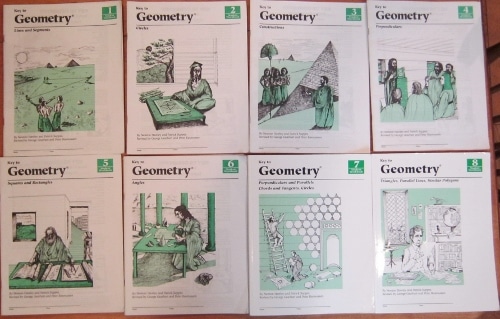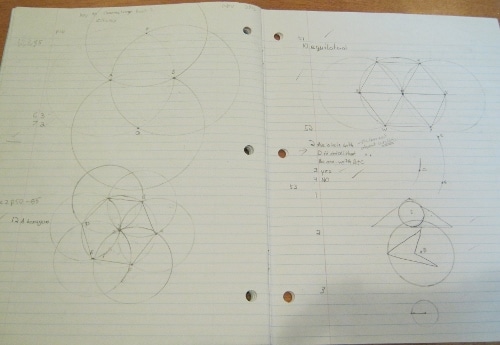Do you know what Miss 13 and I do every day? We sit down on the couch with Key to Geometry, a unique, hands-on geometry course, and spend some happy time together.
Presented in eight booklets (the first six just over 50 pages each and the last two around 150 pages each), Key to Geometry is a discovery-based approach to the topic. This is a hands-on course and on every page the student works with a pencil, compass, and straightedge to construct figures and to discover their properties. The student learns about lines, segments, circles, perpendiculars, squares, rectangles, angles, parallels, chords and tangents, triangles, and polygons. The booklets’ instructions are clear, and the student discovers concepts by following directions step by step.
Key to Geometry features a lot of review. At a certain point the review may become tedious for some students, but others do need it all.
The Answers and Notes booklets contain every solution, drawn out in detail, as well as hints on proper use of the tools (compass, pencil, and straightedge). The “General Suggestions for Teaching” emphasize the importance of accurate neatness, and encourage teachers to get out of the way and let the students discover on their own, both concepts reminiscent of Charlotte Mason’s ideas.
Miss 13 is learning a lot about basic geometry, about how lines, angles, and arcs can be used, and about how to think logically without numbers. She’s also developing her intuition about shapes, lines, angles and arcs.
Because of the sequence of our other math books, we do this course in either 7th or 8th grade and typically take one to several months to get through it. I begin it orally with my kids, at the rate of 10-30 pages a day, depending on the child. As long as the concepts are easily understood, we use our hands to mimic the compass and use an imaginary ruler (contrary to the course’s recommendations), and daily I assign a bit of careful, neat pencil and paper work from the frequent reviews. If the subject matter becomes difficult for the child, I assign more pencil and paper work. Note that these booklets are meant to be workbooks to write in. Due to the cost and the fact that we have five children, our children use scribblers to do their work and use the booklets as textbooks.
Just like the other Key to… courses, Key to Geometry is sometimes advertised as an introductory course or a simpler course for those who cannot manage a formal geometry course. Used in this sense, Key to Geometry would be manageable for someone in grade 7-12, and could be used as a practical or introductory component of a formal geometry course in high school, although it is not a high school credit in itself.
However, I strenuously object to the idea that these booklets are to be used only with slower students. They can also be used as enrichment for talented math students who need a hands-on approach to connect their intellectual approach with the real world. If your child is gifted in math, as some of mine are, whizzing through this course will round out their intuitive understanding of angles, lines, arcs, and figures and give their minds new and creative ways of thinking. Gifted math students of all ages, 10 to adult, could use Key to Geometry to deepen their intuitive understanding of geometry and the physical world. In fact even I, with a Ph. D. in physics, find that each time I go through this course with my kids my mind expands in some unpredictable way—this time I’m musing about crystallography.
This is my fourth time through the course, and I value it more each time. I enjoy how it makes my children tap into a different way of learning, how it reinforces the importance of careful and precise work, and how much of it can be done together on the couch. I do not enjoy marking the pencil and paper assignments which is an extremely tedious procedure, but then, nothing’s perfect.
I also really enjoy the little math history discussions, related to the cover, presented in each booklet.
Disclosure: We have owned this course for many years and are not compensated for this review in any way.
By Annie Kate



Thanks for the review. I’m thinking about using this as a prequel before starting Teaching Textbooks Geometry next year.
I have thought about using this as I have used Key to Algebra previously and found it very good for a student who did not enjoy algebra until he did this .
Lynn, this will be a helpful prequel and give your student an intuitive understanding that will make a formal course more meaningful.
Cynthia, Key to Geometry approaches its subject differently than Key to Algebra does, but even so it can really help a student learn to love geometry.
Hi, I may be missing something but is there a link to the place where you can look at buying them, ie the levels, prices, etc. Thanking you.
I have bought the Key to Geometry (and all the other Key to curricula) from an ordinary homeschool curriculum supplier, but you could also check out the Key to website: http://www.keycurriculum.com/products/key-to
Tkx Annie Kate – am in NZ so not always easy to source stuff here. 😉